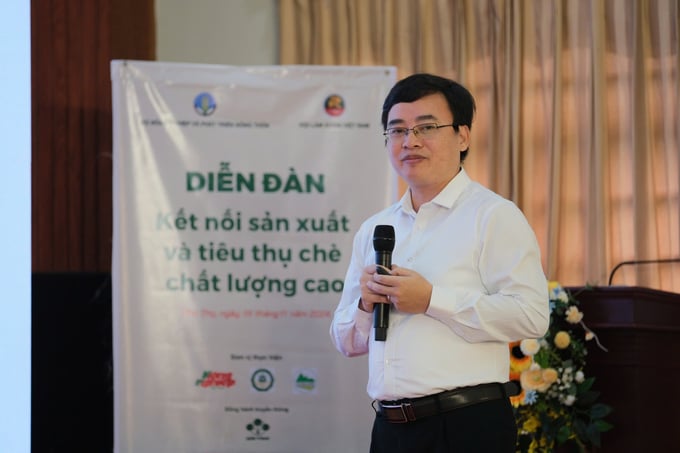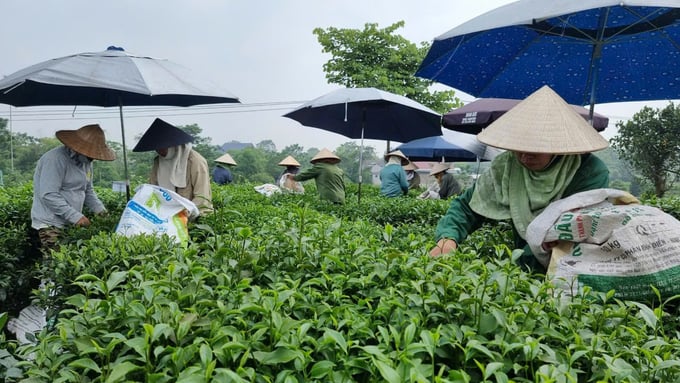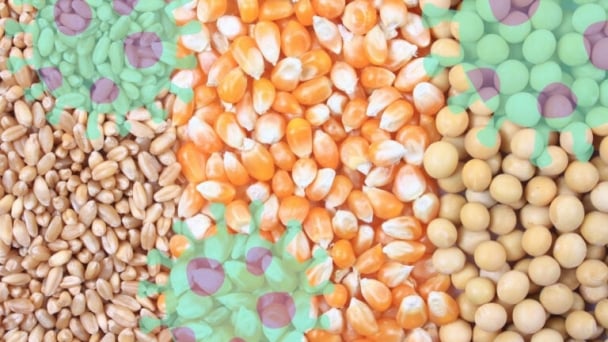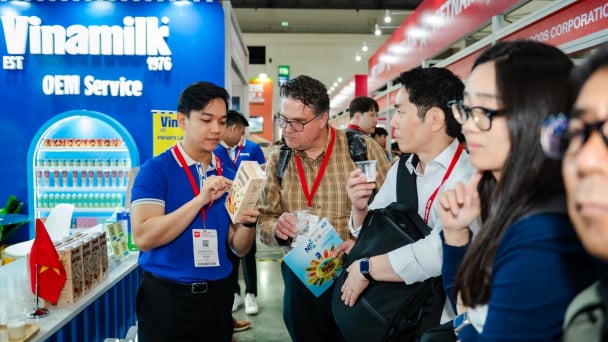June 6, 2025 | 08:25 GMT +7
June 6, 2025 | 08:25 GMT +7
Hotline: 0913.378.918
June 6, 2025 | 08:25 GMT +7
Hotline: 0913.378.918

Mr. Nguyen Quoc Manh, Deputy Director of the Plant Cultivation Department, Ministry of Agriculture and Rural Development. Photo: Quynh Chi.
Tea is one of the indigenous plants in Vietnam, and it has been developed into a major industrial crop, playing a crucial role in the country's agricultural economy. As such, Mr. Nguyen Quoc Manh, Deputy Director of the Plant Cultivation Department under the Ministry of Agriculture and Rural Development, emphasizes that the development of the tea industry is not only a responsibility but also a duty of the agricultural sector. This is vital to ensure that the tea industry can fully realize its potential and thrive in line with its historical roots.
Mr. Manh pointed out that while the area under tea cultivation has slightly decreased, tea production has continued to increase due to higher yields. Specifically, the total tea production has grown from 1 million tons in 2015 to 1.125 million tons in 2023. In terms of regional production distribution, the majority of tea output in Vietnam comes from two main areas: the northern mountainous region and the Central Highlands, which together account for 74.7% and 10.94% of the total production, respectively.
"In 2022, Vietnam produced a total of 194.000 tons of tea, with approximately 146.000 tons being exported, generating an estimated value of 237 million USD. The remaining 48.000 tons of tea, or about 25% of the total production, were consumed domestically, valued at around 7.500 billion VND (approximately 325 million USD). Although the volume of tea consumed within the country is only one-third of what is exported, the value of domestic consumption is significantly higher. This discrepancy highlights a key challenge for the Vietnamese tea industry: how to increase the export value to match the growing demand and value of domestic consumption", stated Mr. Manh.
Looking ahead, it is anticipated that the demand for high-quality tea, especially high-quality green tea that is safe and meets consumer health standards, will continue to grow within the domestic market. Domestic consumption is projected to reach around 60.000 tons annually, representing roughly 25% of the total tea production in Vietnam. At the same time, tea exports from Vietnam are expected to increase gradually, with a forecasted export volume of 136.500 tons by 2030, growing at an average annual rate of 0.82%. This would account for approximately 80% of the country’s total tea production
Despite the projected high consumption and export volumes, Mr. Manh pointed out that the dominant tea production model in Vietnam remains small-scale, with around 600 medium and small-sized tea enterprises. In addition, more than 10.000 households are involved in the production of green tea, using mostly manual and semi-manual processing methods. The capacity of these traditional processing units accounts for up to 50% of the total green tea output in the country.
"The evaluation of Vietnam's tea processing technology shows that it is currently at an average level. Therefore, there is still significant room and potential to improve technological standards and invest in further development", the representative from the Plant Cultivation Department explained.
As of now, Vietnam has successfully developed and processed approximately 15 different types of tea, with the primary products being black tea and green tea. However, the value of Vietnam’s finished tea products remains relatively low, only around 70-75% of the value of similar tea products on the global market.
In order to develop safe and high-quality tea production, a range of policies and guidelines have been introduced, not only by the central government, but also by local authorities in key tea-producing provinces such as Lao Cai, Son La, Ha Giang and Tuyen Quang.
According to a representative from the Plant Cultivation Department, improving tea production areas and enhancing tea quality require a strategic approach. This includes building safe tea-growing regions, selecting suitable tea varieties, and establishing clear product quality standards. Additionally, there is a need to plan and develop tea processing factories to add value. For regions below 500 meters in altitude, the focus should be on cultivating high-yield, safe tea suitable for black tea production. For areas between 500 and 800 meters, the goal should be to produce high-quality tea that can meet the demands for both premium green tea and black tea. Areas above 800 meters, on the other hand, should be dedicated to producing specialty green teas, Oolong tea, and organic tea, which are highly sought after in niche markets.
Furthermore, it is important to link these specialty tea-growing regions with the government’s OCOP (One Commune One Product) program, which promotes local products and enhances rural development. Additionally, integrating tea production with tourism development could not only increase the value of Vietnamese tea but also provide economic benefits to local communities.

According to the Key Crop Development Project, by 2030, the nationwide tea planting area is expected to reach approximately 120.000 to 125.000 hectares, with a yield of 110 to 115 quintals per hectare. The production volume is projected to reach around 1.2 to 1.4 million tons of fresh tea leaves. Photo: Tung Dinh.
In addition, it is essential to accelerate the organization of safe tea production and establish stronger linkages for tea consumption. This should go hand-in-hand with enhancing the capabilities of agricultural extension workers and encouraging the active involvement of quality certification organizations such as UTZ Certified and Rainforest Alliance (RFA).
Moreover, local governments must focus on fostering stronger partnerships between farmers and tea processing factories. Additionally, increasing the frequency and thoroughness of inspections throughout both the production and processing stages is necessary to guarantee that tea meets safety standards and quality requirements. Another essential solution is the improvement of processing capacity. This includes reviewing and upgrading existing processing facilities, modernizing equipment, and incorporating advanced technologies. Ensuring that processing methods align with food safety standards is paramount, as is ensuring the traceability of products.
In terms of science and technology, it is essential to invest in modern technology and adopt technical processes that are suitable for different soil types. This includes developing a diverse range of tea products such as Oolong tea, matcha, and bottled tea beverages. Safe farming practices, the use of organic fertilizers, and Integrated Pest Management (IPM) methods should also be widely implemented to improve the overall quality and sustainability of tea production.
In the area of market development and trade promotion, Mr. Manh suggested that boosting e-commerce and leveraging digital economic tools, such as green banking and green credit, is crucial for the tea industry's growth. Additionally, activities that enhance supply-demand connections, link production regions with distribution systems, and capitalize on opportunities from free trade agreements like CPTPP and EVFTA will help expand both domestic and international markets. These efforts will ultimately play a significant role in increasing the value of the tea industry and expanding its global footprint.
According to the approved strategic plan for key industrial crops by the Ministry of Agriculture and Rural Development (MARD) under Decision No. 431, by 2030, the nationwide tea planting area is expected to reach approximately 120,000 to 125,000 hectares. The productivity is projected to reach 110 to 115 quintals per hectare, with a total production volume of around 1.2 to 1.4 million tons of fresh tea leaves.
Of this, 90% of the tea area will apply Integrated Pest Management (IPM) or Integrated Pest and Health Management (IPHM) practices. Additionally, over 70% of the tea production will adhere to good agricultural practices (GAP), ensuring that it meets global standards such as GlobalGAP, VietGAP, and organic certification or equivalent. Furthermore, more than 70% of the tea plantations will be certified with traceability systems, allowing for product origin traceability through a unique plantation code.
Translated by Phuong Linh

(VAN) Crops contaminated by mycotoxins may be costing poultry organisations more than £150,000 (€178,000) in losses annually.

(VAN) New research has identified the mechanism by which air pollution damages the lungs’ self-cleaning system, leaving us vulnerable to infection.

(VAN) On June 4 (local time), Deputy Minister of Agriculture and Environment Nguyen Hoang Hiep and the delegation attended the Global Platform for Disaster Risk Reduction (GP2025).

(VAN) UNESCO has officially awarded the Certificate of Recognition designating Lang Son Geopark as a UNESCO Global Geopark.

(VAN) The Food and Agriculture Organization of the United Nations (FAO) has appointed Alue Dohong as Assistant Director-General and FAO Regional Representative for Asia and the Pacific.

(VAN) Reuters, AP News, Washington City Paper and other outlets reported on the recent large-scale agricultural trade cooperation event between Vietnam and the U.S.

(VAN) At Thaifex Anuga Asia 2025, Asia’s leading food and beverage trade show, more than 170 Vietnamese enterprises are participating, with Vinamilk having been a consistent presence for nearly 20 years.